We are taking about Hatch Covers
Every cargo ship, other than tankers is provided with large size hatchways on deck to facilitate loading and discharging of cargoes. This causes loss of strength at the deck level, which has to be adequately compensated. Furthermore, the hatchways have to be suitably covered, before the ship can proceed to sea, to prevent entry of water into the cargo spaces.
In order to achieve the above purpose you should learn about the construction of different types of hatch cover and the precautions required for operating and maintaining them. One of the first tasks to commence cargo operation is to open and close the hatches where the cargo is to be stowed.
The opening and closing of these large openings is not a simple task in spite of the mechanical aids available. If not done properly it may lead to unsafe conditions and hence the stringent procedures.
What is the main Aim??
To explain and describe the arrangements on board cargo ships for opening hatchway for cargo operations, and closing it to maintain the weather-tight integrity of the ship.
Construction of hatchways
Hatchway is a big opening on deck, and is an essential part of any cargo ship for loading and discharging cargoes. Its dimensions depend on the type of ship and the nature of cargo, which the ship would usually carry.
The total cargo space of a ship is divided into a number of compartments or holds to facilitate cargo operations, and a separate hatchway is provided for each hold.
The length of the hatchway restricted to allow for fitting of mast houses, cranes, derricks, winches and ventilators on deck in between the hatchways. The breadth of the hatchway depends on the expected dimensions of the cargo to be loaded and the need for leaving open deck space for other purposes.
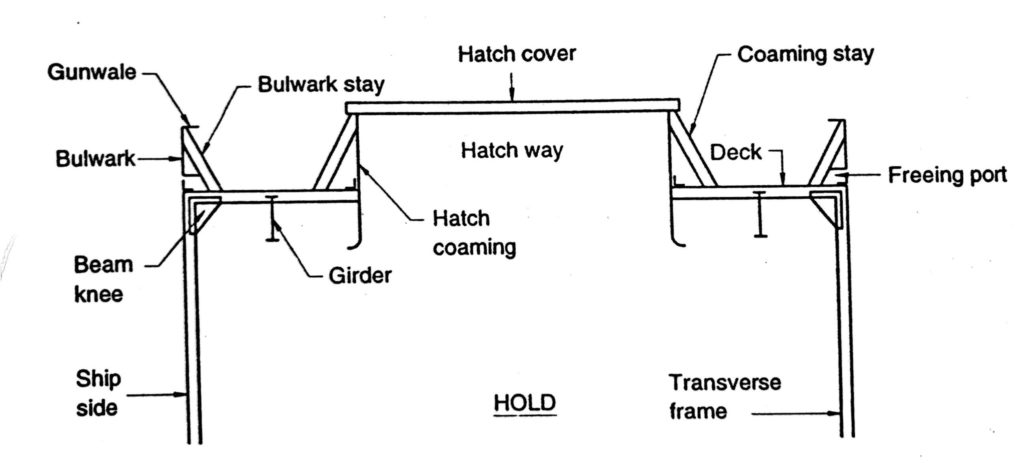
Constructing a hatchway means cutting a large opening on deck, which obviously reduces the overall structural strength of the ship at the deck level. Hence, the size of the hatchway cannot be increased.
Furthermore, the hatchway has to be adequately covered by pontoons of suitable size. This means that each pontoon, extending across the breadth of the hatchway, has to be adequately strengthened for sea-going condition, to prevent any sagging in the middle.
Pontoons often carry cargo on top and have to be the load of seas in rough weather.
General cargo ship
The cargoes on such ships consist of bags, boxes, bales, bundles and similar packaging. Sometimes large size commodities like vehicles. pipes, rails, rods etc. may also be loaded.
For such cargoes, the site of the hatchway does not have to be too large as shown the cross-sectional drawing above. This leaves sufficient deck space for, loading cargoes on deck, which do not require special protection from weather, or which, because of their size or nature, cannot be conveniently loaded under deck.
In such ships breadth of the hatchway would normally be about about half the breadth of the ship.
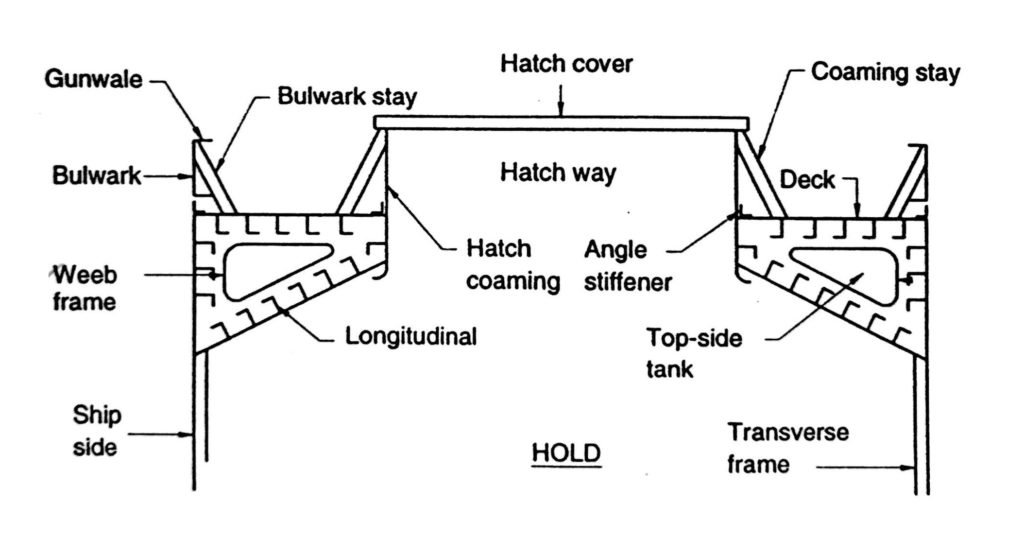
Bulk Carrier
On such ships, the cargo is loaded by chutes and generally discharged by large grabs. Unlike on a general cargo ship, there is no involvement of labourers for stowing or securing the cargo. Hence, in order to ensure that the cargo being loaded reaches all the corners of the hold and the grab conveniently picks up the cargo from all over the hold, it becomes necessary to increase the size of the hatchway as shown in the cross- sectional drawing above.
The breadth of the hatchway would normally be about 2/3 rd the breadth of the ship. In any case, as there is no possibility of loading any deck cargo, there is not much need for deck space except for fitting cranes, mast houses, etc.
Container Ship
Container ship If a ship is fitted for loading containers, then the size of the hatchway has to be very large. The container is a large steel box of dimensions 20-ft x 8 ft x 8 ft or 40-ft x 8 ft x 8 ft.
The height of the container varies from 8 ft. to 9-1/2 ft. When fully loaded its weight ranges from 20 tons to 45 tons. Obviously, it has to be lifted by special devices and, when lowered into the hold, it cannot be shifted sideways by any method. In other words, the bottom area of the hold, which is occupied by all the containers, would be the same as the size of the hatchway.
This. would leave a considerable amount of empty space around the containers, which will be a big loss for the ship owner. Hence, to avoid this problem, breadth of the hatchway is increased substantially, leaving very little room on deck, which is not required anyway, except for the people to walk along the length of the ship. The length of the hatchway is also increased as much as possible. The breadth of the deck space on either side of the hatchway is just about 1 metre.
As can be seen from both figures above,, each pontoon of the hatch cover rests on the hatch cowling at the extreme of the hatchway. Due to the long unsupported span of the pontoon, it has to be made structurally strong to prevent it from bending in the middle.
In case of a container ship, if the breadth of the hatchway is substantial, as already explained above, then each pontoon has to be constructed extra strong and be of substantial depth. This will be rather difficult to achieve and would create other problems of handling, operating and maintaining them.
To overcome this problem, the full hatchway is divided into smaller hatchways side by side as shown in the cross sectional drawing below.

Height of hatch coaming
In all the figs above, the hatch coaming, with the hatch cover distinct common on top of it, is a common feature. it is like a wall around the hatchway, whose height differs from ship to ship due to various reasons, which are explained below:
As per Rules, the hatch coaming should be at least 75cm. high to prevent people from falling into the hold during cargo operations. The above rule could be also complied with by providing portable railing upto 1m high around the hatchway, which could be rigged at the time of cargo operations. In that case, the hatch cover would have to be fitted at the deck level itself. This would mean that, when the cover is in the closed position and the ship is at sea, any water flowing on deck would continuous flow over the cover also.
This would increase the possibility of leakage of water into the hold. To prevent this, the cover would require very elaborate and extensive closing devices to make it so watertight that even if it was under water, it would not leak. If such closing devices were provided, then considerable time and manpower would be required to open and close the cover, which may have to be done very frequently during cargo operations.
To avoid all these problems, the hatch cover is raised above the deck by providing the coaming around the hatchway. Having done so there is no need to provide extensive closing devices. As long as the cover in closed position can withstand the usual weather conditions like rain, sea sprays, etc. there is no need to make it totally watertight.
The water, which may flow on deck during heavy weather, is not likely to leak through the cover at the raised level. This is termed as weather tight. Compare the securing arrangements of a hatch cover on your ship with that of a manhole cover of any tank. The latter is usually tightly secured by at least 20 to 24 nuts and bolts. This makes the manhole cover totally water tight, so much so that even if the tank is pressurised from inside, it will not leak at all. ‘This arrangement is necessary because the tank containing any liquid is not going to be opened very frequently.
Note This !!!
“If the hatch cover, which is much bigger than a manhole cover, has to be made as watertight as the latter, then it would probably require few hundred nuts and bolts, which is totally impracticable”
With the permission of the chief officer, open and close a manhole cover on your ship. Do it alone or may be with one other person to help you, and record the time needed to do this work. From this time period you can estimate the time and the man power required if the hatch cover with few hundred bolts have to be opened or closed”
The overall watertight integrity of the ship is governed by the Rules given in the International Load Line Convention. One of these rules deals with the weather-tight integrity of the hatch covers. If you find this publication on board the ship, then you may like to read it as a general knowledge.
Important
That is why we always say, and the Rules require it to be so, that the hatch covers are supposed to be weather-tight and not necessarily watertight.
If the hatch cover, placed on top of the coaming, is opened in the fore and aft direction, which is usually the case, then 1 m height of coaming is probably sufficient. However, in certain bulk carriers rolling the covers sideways towards either of the ship’s side open the covers. This would naturally encroach upon the deck space. Hence, the coaming height is increased sufficiently so that, after the cover is opened, the people will be able to walk freely underneath it.
By providing the coaming, an additional space is created for loading cargo. This is not important on general cargo ships where mostly packaged cargo is loaded. However, in bulk carriers, this space comes in very handy when low-density cargoes like grain, fertilisers, etc. are loaded. A ship loading such cargoes will not be submerged up to its maximum draft, even if all its holds are filled completely. Hence, the extra space inside the coaming will help the ship to carry more cargo and thus earn more freight. Depending on the requirement of the ship owner, the height of the coaming is suitably increased.
Whenever bulk cargo is loaded, particularly of the low-density type, invariably empty pockets are created under the deck, which cannot be filled by any mechanical means. These pockets allow the cargo to settle down and/ or shift once the ship starts rolling at sea. This could cause the ship to list dangerously to one side. One way of avoiding this problem is to fill the coaming space with cargo, which will act like a feeder for the main hold. Now, when the cargo in the hold settles down, the cargo in the coaming space will fill the empty pockets, thus preventing the cargo from shifting and the ship from listing,
On container ships, containers are invariably loaded on top of the hatch covers to enable the ship to be submerged up to its maximum load draught. To make optimum use of the hatch covers and deck space, the containers are placed across the full breadth of the ship, from bulwark to bulwark. This would mean that the containers would also extend across the deckspace on either side of the hatchway. Hence, the hatch coaming is sufficiently raised so that, after the containers are in position, the crew can walk freely underneath them.
Construction of hatch coaming
Hatch coaming of a suitable height is an essential part of the hatch closing arrangement. it also has to be made sufficiently strong to withstand the weather conditions and to support the weight of the hatch cover and the weight of cargo loaded on top of it. Below shows the cross section of the coaming with its connection to adjacent parts of the ship.
This type of construction will be commonly found on general cargo and container ships. The wheel support is adjustable so that when the hatch cover is in the closed position, the support is lowered to allow the hatch cover to rest on the coaming . Other methods are used for different hatch covers to make them sit firmly on the coaming.
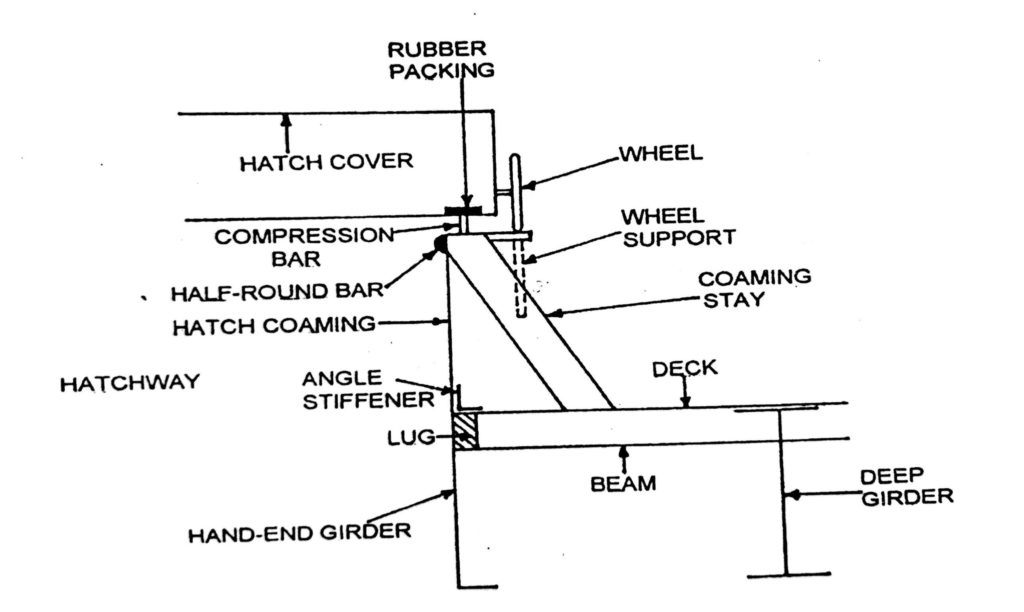
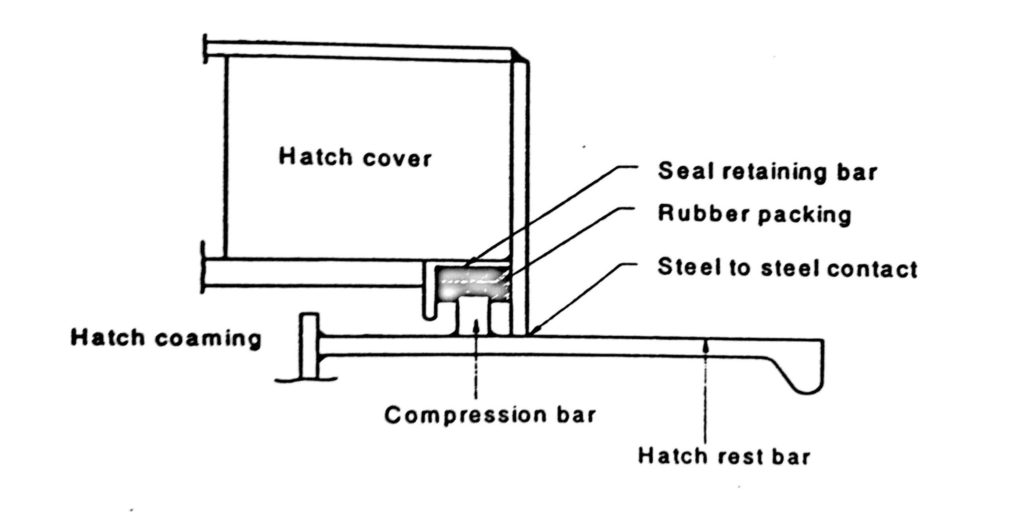
Rubber packing is provided around the sides of hatch covers, which will press on the compression bar fitted on the coaming, thus providing weather tightness. To make sure that the hatch covers are firmly secured to the coaming, cleats are provided along the sides of the coaming as shown in the below Fig .
Different designs of cleats are found on different ships. Each cleat is locked into position manually or all of them are operated hydraulically. The half-round bar shown at the top edge of the coaming is meant to give additional strength to the edge so that it can withstand any accidental impact by the cargo gear during cargo operations. It also prevents long-term wear of the edge of the coaming due to rubbing of the derrick gin-fall wire.
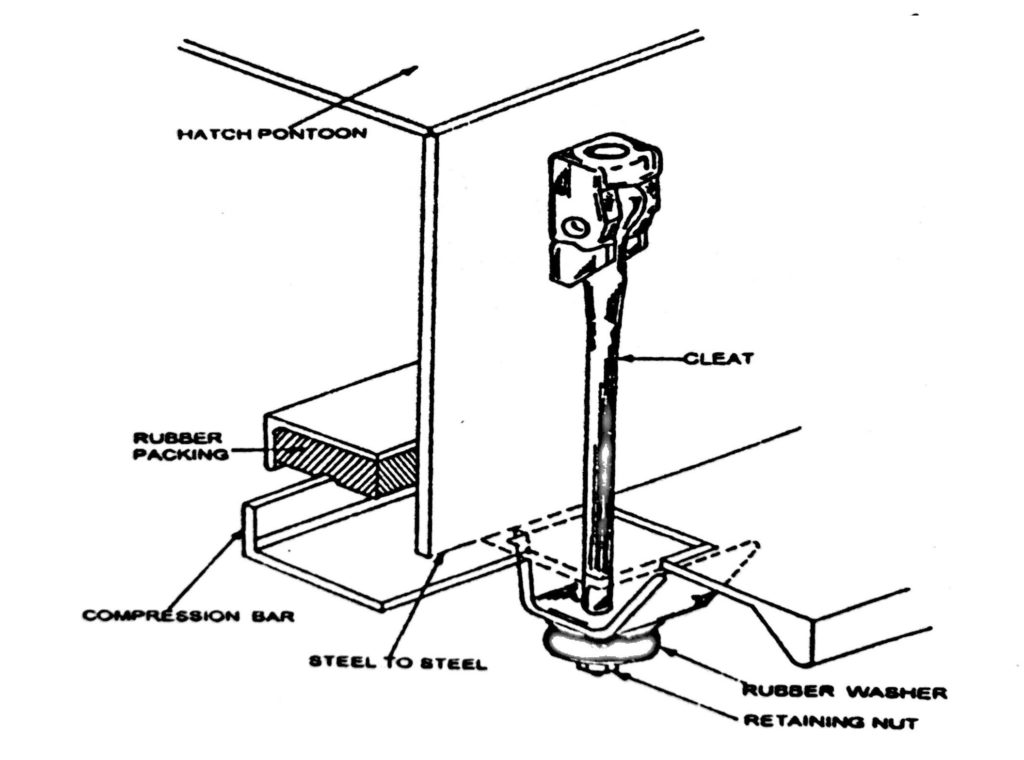
Below figure shows the cross-section of the coaming and adjacent deck space of a bulk carrier.
Here the main difference is the provision of topside tanks and the longitudinal framing system inside them. These tanks are located under deck and extend on either side of the coaming up to the ship’s side.
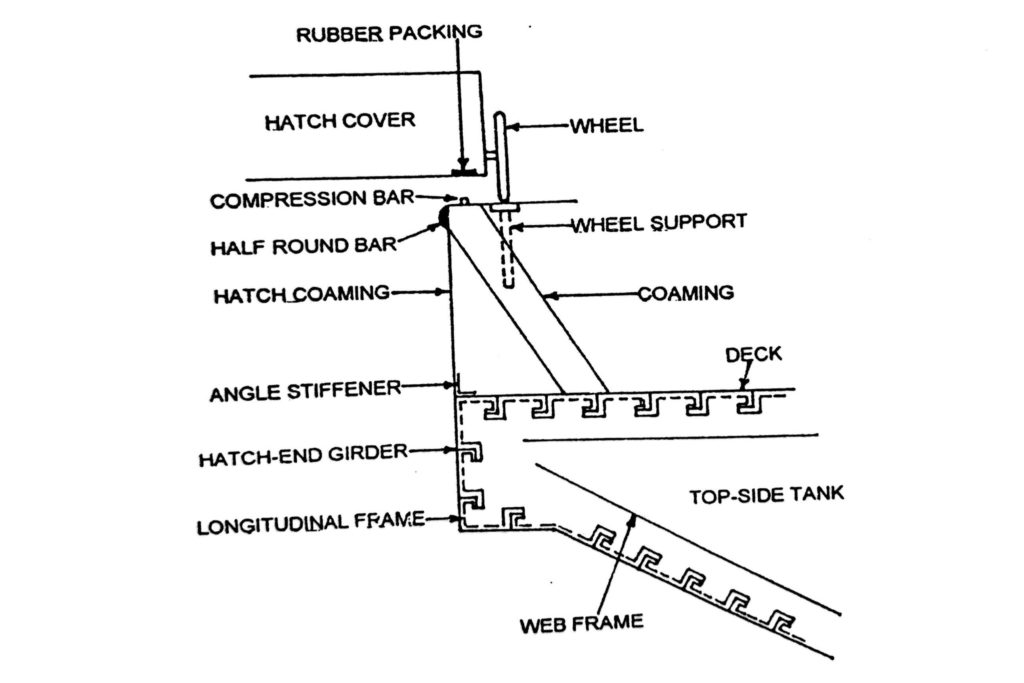
Purpose and working of different types of hatch covers.
Purpose of hatch cover
► The essential purpose to close the hatchway when the ship proceeds to sea. This prevents any rain or heavy seas from entering the cargo hold and damaging the cargo. Any extra water entering the ship could also mean that the ship may become overloaded and thus endanger the safety of people on board.
► In case of fire in a cargo hold, the hatch cover will ensure that the supply of oxygen is restricted; this would prevent the fire from aggravating and spreading to the other compartments.
► Hatchway cut through the deck removes a large number or beams, girders, etc as well as the deck plating itself. This considerably reduces the longitudinal and transverse strength of the deck. If a strong hatch cover is provided and firmly secured to the deck via the hatch coaming, it would substantially compensate the loss of strength. The key structural members in this compensation the loss of strength.The key structural members in this compensation of the loss of strength are the side cleats, because they hold the hatch cover firmly down and secured to the coaming.
► It is very common to load cargo on deck and on top of the hatch cover of general cargo and container ships. This means that the cover has to be made strong enough to take the load of the cargo if the owners so require it. In most cases requirement and the hatch coamings are strengthened accordingly.
Note this!!!
It should be clearly understood that the side cleats of the hatch cover are meant to achieve the following purposes:
► They make the hatch covers weather tight by ensuring that the covers do not jump up or shift longitudinally or transversely in heavy weather.
► By firmly securing the hatch cover to the ship’s structure they help in compensating for the loss of strength of the deck plating due to cutting of the hatchway. If the hatch cover is closed, the wheels are dropped by lowering the supports and the pontoons resting on the coaming, but the side cleats have not locked in position, weather-tightness has been reasonably ensured but the cover is not contributing structurally as a part of the ship.
► To ensure that the transverse strength is maintained in case the ship receives a beam on impact. If the hatches were open, such impact may cause bending of coaming and. result in misalignment of the pontoons and their sliding off the trackways. Such impact may occur due to the ship corning heavily alongside the jetty or a tug making a hard contact with the ship or due to a minor collision.
► Hence it is strongly recommended that, wherever the ship has to move out of the Jetty, the hatch cover should not only be closed for the protection of the cargo from weather but all the pontoons should be firmly secured by means of cleats provided so that any accidental impact would not affect the deck or hatch coaming
Testing Hatch Covers For Water tightness
The necessary maintenance can be both labour intensive difficult arrange between busy loading schedules. Sometimes hatches leak despite careful maintenance. Hatches that appear to be in satisfactory condition when a ship is in port and berthed in still water, may start to leak when the ship is in a seaway and subjected to raking stresses. it is however true to say that if hatches are found to leak in port, they are sure to leak in a seaway. A well-planned programme of maintenance should effectively ensure that any risks of leakage are kept to a minimum.
Frequently, surveyors are instructed to attend ships and test hatch covers for watertight integrity and there is some debate as to how this should best be done. There are several options open to the surveyor wishing successfully to carry out such tests, and the best approach may be to follow a combination of several procedures.
The simplest initial test may be to have the hatch battened down and then to enter the hold and look upward. In some more drastic cases this test may demonstrate the existence of leaks, simply because daylight can be seen through the gaps in the seals or through wasted covers.
In the majority of cases, a more sophisticated test will be necessary. Some surveyors believe that when such tests are being made, the hatches should not be battened down tight but merely resting on the compression bars, with steel-to-steel contact. The weight of the cover should, it is said, be sufficient to ensure a tight seal. Practically speaking it is usual to tighten down the hatch covers and present them for test in the same condition, as they would be if the ship were laden and ready to proceed to sea.
The most commonly used test is the hose or water test whereby a jet of pressurised water is directed at the seams and joints of the hatch covers. Systematically, all the vulnerable areas of the hatch covers are examined. The surveyor, during this test, is stationed within the hold, so that he can see if there is any leakage. It is clearly essential to ensure that the water, usually supplied from the ship’s fire main, is supplied at a constant and sufficient pressure and that the hose is steadily directed in the proper direction. In some cases, it may be appropriate for two surveyors to be engaged in the test, one on deck and one in the hold. Ideally, the hose should be held at a distance not exceeding one metre from the joint under test, with a pressure not less than recommended by the class.
There are a number of disadvantages to this test apart from the fact that it is time-consuming. The first is that it may be difficult to ensure adequate water pressure. Furthermore, a good deal of water is generated on the deck of the ship and there may be practical objections to this, particularly if the water is shed over a quay or into a dock with a possible risk of pollution. If leakages are suspected, the test cannot be carried out when the ship is laden with cargo, for fear of wet damage.
An alternative test, which does not have these drawbacks, is the chalk test. The aim of the chalk test to verify whether there is good continuous contact between the rubber joints and the compression bar. Chalk is applied to the compression bars and the hatches are then battened down. They are immediately re-opened and the joints examined. When a clear, regular mark is observed on the joint, it is assumed that sufficient pressure exists between the Joint and the compression bar. If the chalk mark is found to be irregular or less pronounced at one point than at others, then it is assumed that there is some doubt as to watertight integrity. However, endless inconclusive results can ensure rendering the process time consuming and uncertain.
There is a school of thought, which contends that these two tests belong to a past age and that ultra-sonic testing is the most reliable, precise and rapid method available to test the integrity of the tanks. Testing by ultra-sonic equipment gives the exact location and extent of any leakage, is easy and quick to operate, does not require assistance from crew members and most importantly, can be used on laden or unladen ships without any risk of cargo damage. Unlike the hose test, it can also be used when temperatures are below freezing.
The procedure is to close the hatch covers and place inside the cargo hold an ultra-sonic generator or transmitter. When activated within the hold, the range of the generator (in fact there are several transmitters on each generator) is 60 metres. The receiver or detector, which is outside the hold, picks up the signals and converts them to audible frequencies. The detector also measures and shows the maximum value of an observed signal in decibels. By manoeuvring the detector around close to the seal, any leakage can be precisely detected by observing any change in the sound recorded. A record is kept of the location and extent of any leakages detected. After testing, it is usual to carry out a visual inspection of the affected areas. Surveyors carrying out condition surveys for the UK P&i Club are being encouraged wherever suitable, to use ultra-sonic equipment in conjunction with visual and other well-tried tests.
One thought on “Opening & Closing of Cargo Spaces”